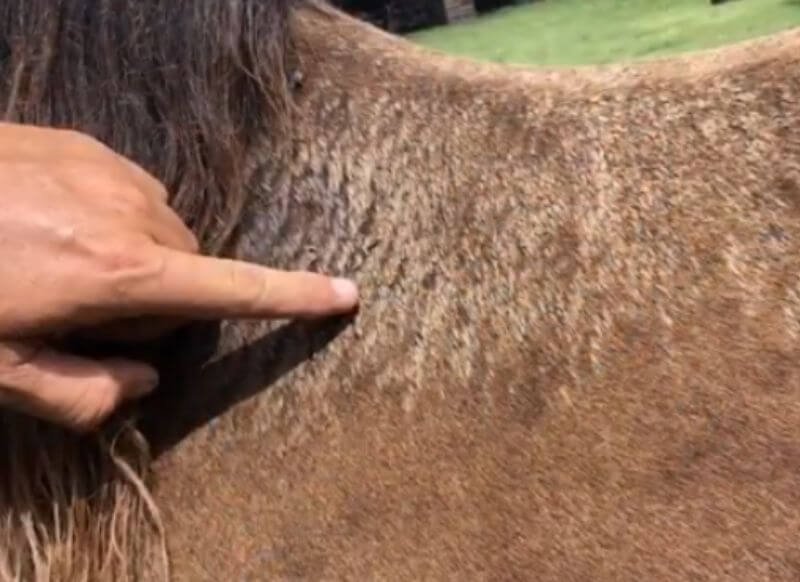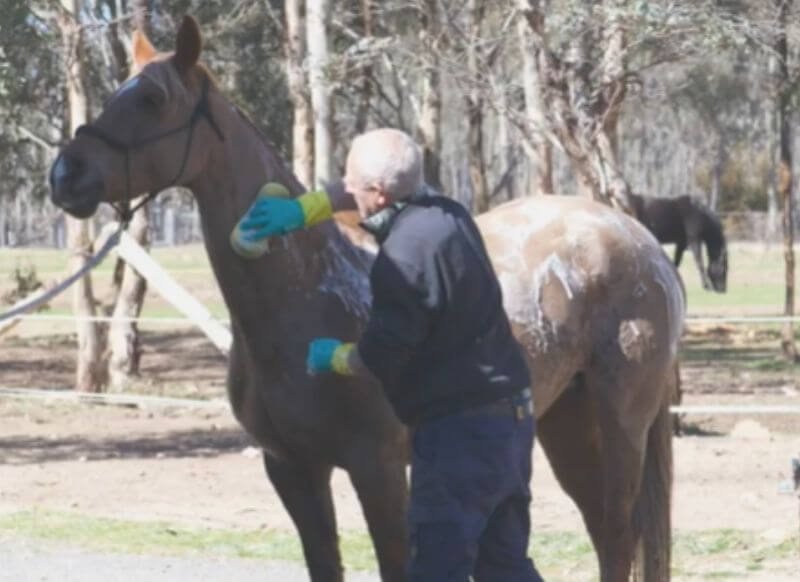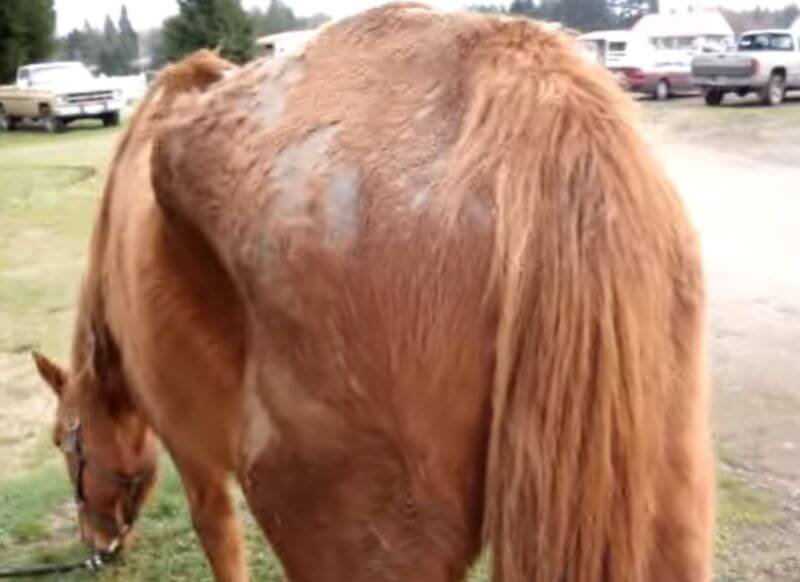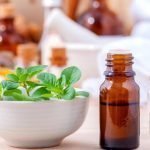It is painful to see your horse suffering from a bacterial skin disease known as rain rot. The rain rot occurs mainly in those areas where there are more wet and dry conditions.
Various factors can cause rain rot in horses. Taking prevention is the best way to deal with such a disease. Let us know all the factors and remedies of rain rot.
Causes of Rain rot in Horses You Ought To Know
A bacterial infection causes rain rot, also called dermatophilosis, and this disease is 1often mistaken as a fungal disease, which is not valid. Such bacteria survive on the outer area of the skin and form crusty scrabs or lesions on surfaces. These bacteria start to grow where there is prolonged wetness, high temperature, humidity, or even on the surface, which was bitten by insects. This disease can also be spread from horse to horse through flies and other insects.

Moisture is the main reason for rain rot as the name of the disease suggests the same. The condition is also common in horses with older age who follow the poor nutritious diet and are medically unfit.
How To Get Rid Of Rain Rot In Horses
Diagnosing :
It is quite easy to diagnose rain rot disease, and the examination can be made by scraping the skin for gr bacteria and examining it under a microscope. Horses that have long winter coats develop paintbrush lesions along with dorsal surfaces (neck, back, withers, lower limbs). Light skinned areas of the horse are more affected by these bacteria. If you try to remove the crusty crab formation, you will see yellow-green pus living between the living and necrotic skin layers.
The veterinarian usually takes care of the location, appearance, and size of the lesions. The skin around the lesions is warm and sore, which are quite painful for the horse. The major areas where such lesions occur are chest, neck, back, and hindquarters. These lesions develop in wet conditions and can be spread if not treated at an early stage.
Treatment :
Sometimes rain rot in horses cures on their own but experts say that in some cases they get worse if not treated at an early stage. The lesions formed are very painful for the horse, especially when it’s on the back of the horse. In less severe cases, you can remove the scraps while bathing your horse. In severe scrap formation, you may get an antibiotic injection to your horse by a vet.

There are many products to treat rain rot in horses; all of such products focus on the same concept to cure, which are to soften the skin, remove it, and treat the underlying skin that consists of bacteria. A good antiseptic shampoo can also be used for the treatment of rain rot. The vets prefer Betadine and chlorhexidine for first-line treatment of rain rot. The infection can increase rapidly if not treated at an early stage. The removal of the crust is essential in this disease. Using an antiseptic spray or creams into their hairs is the best option, wait for the hairs to soften up, and then remove the lesions after 15 to 20 minutes.
The initial treatment includes bathing your horse daily with any antiseptic shampoo and spraying of antiseptic on the affected areas of your horse. In the case of severe conditions, the vet can suggest you with prescribed shampoos and spray for better results. Once the infection is cured it will not take much time for hairs to regrow.
Some Useful Tips To Prevent Rain Rot in Horses
Here are some important tips that can help you to prevent rain rot in your horses –
Grooming :
A regular grooming session is required to save your horse from conditions of rain rot. Peek under their blankets, and in case you notice any unfamiliar change, try a course of antibiotics or consult your vet.
Tack :
Expose the tack to sunlight for a few hours regularly to kill the fungus. Dry the tack well before using them. You should also set your tack in such a way so that a small amount of air can enter for air circulation.

Farm Maintenance :
Apart from various rain rot in horses home remedies, several external factors have to be taken care of to avoid such disease. Moisture and damage of the skin are the two significant factors that led to rain rot. Skin damage may be in the form of simple irritation that can be caused by some thorny plants, injury, bugs. So take care of such wounds if it exists on your horse.
Shelter :
Make sure that you provide a dry area for your horse to keep them safe from wet weather. Mud management is also a good practice for the same. Rugs and fly sheets should be used during the fly biting season, and the neck and body of your horse should be well covered. You can also use fly boots that are specially designed for horses to keep their legs protected.
Some Other Effective Ways :
Exposure to sunlight is necessary; it heals all the skin diseases naturally by killing fungus. Make sure that your horse takes at least one hour of sunbath daily. Insects are also a major cause of rain rots. Spread the aroma of rue, lavender, garlic, tansy, citronella, wormwood around their shelter to keep away these insects and flies. Remove and change the manure and water regularly and fill it with new ones. Improve or maintain the immune system of your horse by feeding them nutritious food.

Avoid heavy blankets and switch to breathable ones and regularly change the blankets if your horse is sweating. Clean or the scrabs that come out from your horses and disposed of them is a safe place far from the shelter. Supply your horse with adequate minerals and multivitamins. Do not forget to expose them to sunlight daily as it kills several fungus and bacteria. Make sure that you do not share ant of the blankets or the food of your horse with other horses as the disease is contagious.
DIY Rain Rot in Horses Home Remedies
Remedy#1
You can combine one tube of triple antibiotic ointment with 1% hydrocortisone ointment and nystatin fungal ointment. All the things you can readily get from your nearest drug store. Combine all the above three ingredients to make a thick paste. The antibiotic ointment can fight from infection while hydrocortisone ointment from the fungus.
Apply the paste in affected areas of your horse after washing the area with betadine scrub. It will reduce the itching and repel the flies.
Follow the same procedure daily till the irritation and oozing is completely stopped. You can also witness hair growth in the affected areas in a few weeks. The combination of Listerine and baby oil is also useful to cure rain rot. You have to use each of them at 50:50.
Remedy#2
The other remedy is to mix a 16-ounce of mineral oil and 3% solution of hydrogen peroxide with a bottle of tincture of iodine in a bucket. Soak a sponge in the solution and apply on affected areas of your horse and let the solution stay overnight. This will soften and lubricate the skin of your horse. On the next day, bathe your horse with a mild shampoo and let the horse dry. Make sure that you do not keep concoction in a sealed container as it can form bubbles and explode.
Some Frequently Asked Questions (Faq’s) You May Have
How do you get rid of rain rot in horses?
You can apply treatment such as Theracin to cure rain rot in horses. In severe cases, bathe your horse with a prescribed shampoo before their treatment.
What is the best treatment for rain rot?
The best treatment is to apply Theracin treatment on your horse, consult your vet for proper guidance.
Whether rain rot in horses can spread to humans and other animals?
Yes, rain rot in horses is contagious and can spread to humans and other animals.
Is MTG good for rain rot?
Yes, MTG is good to cure rain rot and several other diseases such as mud fever, sweet itch, itchy skin, and dandruff.
What does rain rot in horses look like?
Rain rots occur when you see the formation of crusty scabs, which gradually peels along with clumps of hair and thus leaving bare spots on the skin of your horses. These rots appear on that part of the body, which is generally exposed to rain like the head, back, and neck of horses.
Can people get rain rot from horses?
Rain rot in horses can be spread to humans or any other animals. Make sure to clean all the buckets and blankets that come in horse’s contact so that it does not spread to other horses.
The Final Words
I hope that now you are able to tackle this frustrating issue in your horses. Apart from the above, there are several other rain rot in horses home remedies. Make sure to try these remedies on smaller areas for observation. In case you see any side effects, stop the treatment immediately.
The best way is to take care of your horse by giving them nutritious food, exposure to sunlight, and keep them in a clean and healthy environment away from moisture to prevent this disease.













